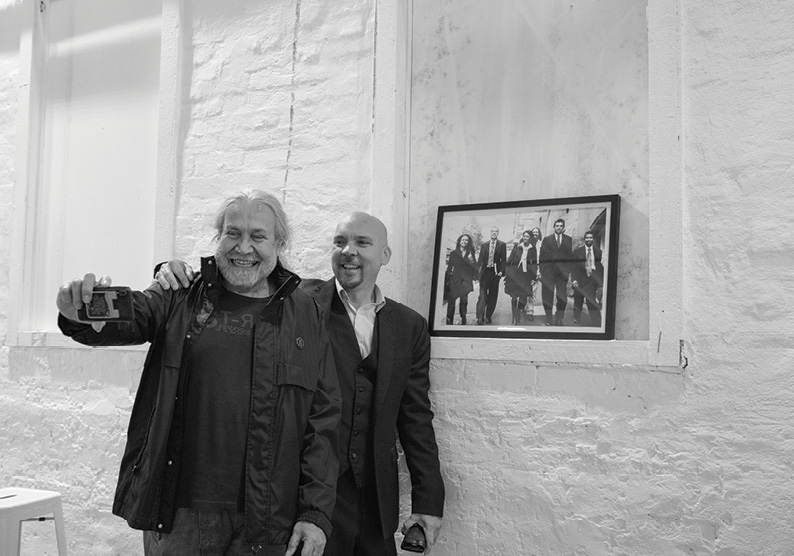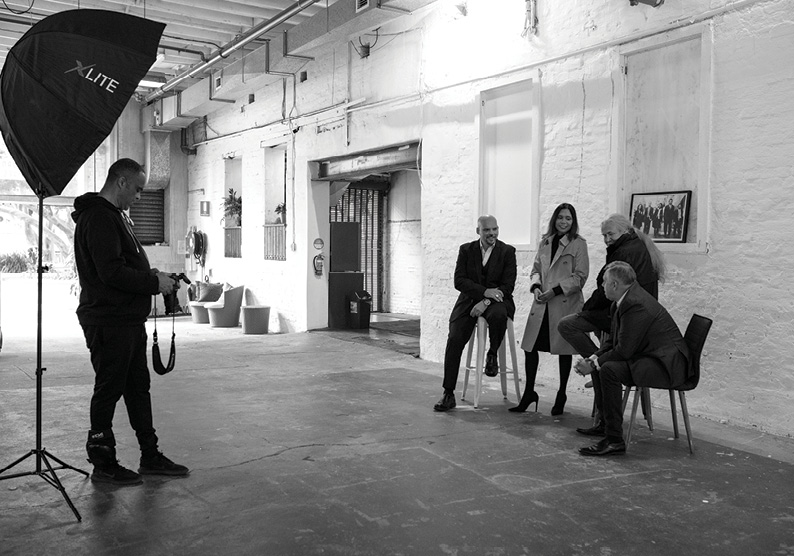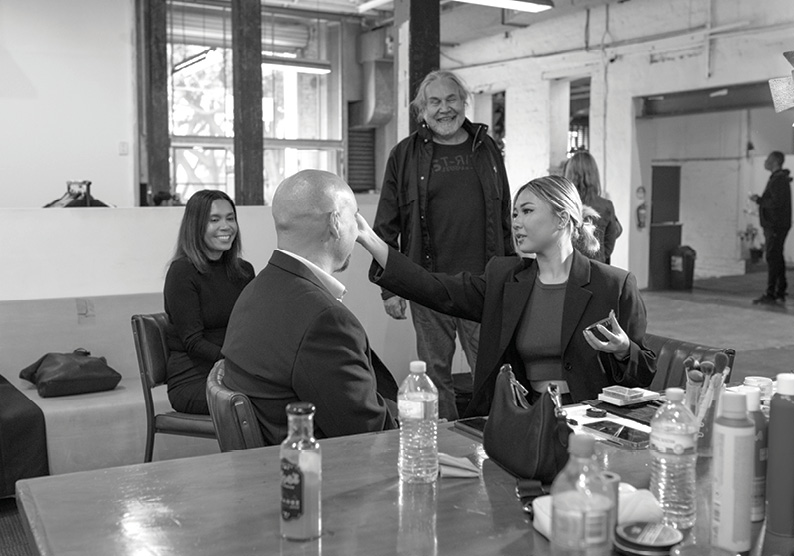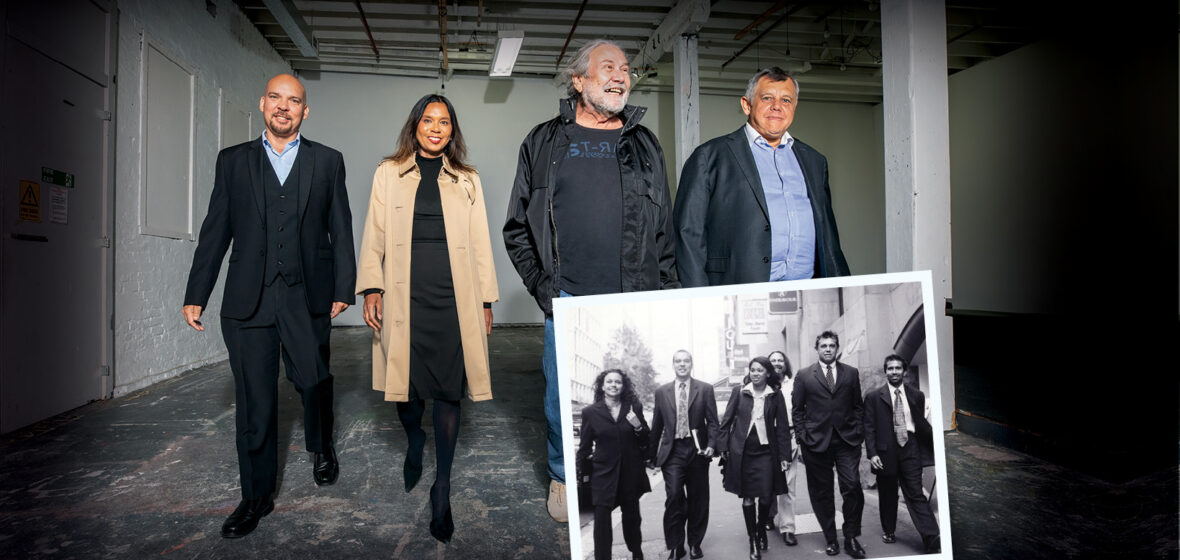Twenty-five years ago, six young, ambitious Indigenous lawyers were photographed walking down the street as one. The Journal brought them back together to re-create the moment – and set a new generation on the same path to forging a better legal system and a better society.
Anticipation thrums in the air as, one by one, the group arrive. Stepping out of Ubers and taxis, walking with purpose into a warehouse studio in a quiet corner of Gadigal land. In a few hours, the annual Ngalaya Ball, celebrating the success of Indigenous lawyers in NSW, will begin. But this daytime meeting is a special gathering, a reunion and reflection on successes that have been generations in the making.
Yiradhu marang (good day). It was 25 years ago that six keen Indigenous lawyers in their nascent careers posed for a photograph that captured them striding down busy York Street in Sydney’s CBD. The snapshot by photographer Jamie James was the key image on a brochure promoting Ngalaya Indigenous Corporation, founded in 1997 by Indigenous lawyer Cal Martin together with 25 Indigenous lawyers and law students in NSW.
Ngayala, from the Dharug and Eora languages, means ‘allies in arms/battle’, the name chosen by Martin to represent how Indigenous lawyers are brothers and sisters in the fight for justice.
Four from this original group – senior legal counsel Damien Bidjara-Barnes, Indigenous cultural and intellectual property (ICIP) expert Dr Terri Janke, native title specialist and barrister Tony McAvoy, and law lecturer and legal consultant Kevin Williams – have reunited to re-create their iconic walk for the Journal on a sunny day in late August, in Cope Street, Redfern. The other two original members, influential lawyer, professor and board Chair Robynne Quiggin and Shaz Rind, activist and founder of the Indigenous-majority-owned company Arra Energy, were not able to be in Sydney, but gladly agreed to interviews on their careers and lives since 1997.
Whilst many in the group have kept in touch, caught up at events and followed each other’s successes over the years, this is a rare moment for all to be in the same room. In one corner sits a blown-up version of that original photo, black and white and brimming with potential.
There is friendly ribbing as they look at the photo – the teasing love you give family – and cheeky debates about who looks older and who doesn’t. About who’s taking the longest in hair and make-up, and who’s a natural when in front of the lens of photographer Joseph Mayers.
Through all the laughs and discussions runs a deep pride. Today these six deadly leaders are dominant in their chosen areas of the legal profession, including environmental law, construction and property law, land rights, human rights, intellectual property law and legal education.
It was the founding of Ngalaya that offered them hope for their future in the legal profession. Yet that hope was mixed with caution, arising from the need to conquer historical obstacles, the obstacles in their own lives, and those that lay ahead for Indigenous people and communities.
But there was optimism as well, because Indigenous culture gave them the strength, wisdom and sense of passion to bring about justice for the Indigenous community, and for all vulnerable people, offering support from their very diverse range of practice areas.

From 1997 to now
Janke, a world leader on cultural and intellectual property law, was also recently a chief author on the Federal Government’s State of the Environment Report – the first time the report had Indigenous co-authors. The report “highlights the importance of traditional knowledge and Western science coming together for protection of the environment,” Janke says.
Bidjara-Barnes has broad legal and commercial experience in construction, mining, rail, energy, resources, environment, planning, local government, property, cultural heritage, land claims and native title. Today he works as a lawyer, negotiating multi-billion-dollar goverment infrastructure projects, such as the Sydney Metro City South West Project and Brisbane’s Cross River Rail Project. He has used his experience in the corporate space to pave the way for other Indigenous people wanting to work for big corporates. He loves using his corporate and commercial legal skills for the benefit of community and encouraging young Indigenous people working in the corporate space to give back to community.
Rind has a proud career in exercising the negotiation skills gained through his law studies: working around the “black and white nature of the law” to get land rights and native title outcomes, to understand and to reflect Indigenous culture and the native title determinations within Land Rights Act outcomes.
“We’ve learned how to harness the firepower of Aboriginal culture and knowledge of land and the environment to get really good outcomes for Aboriginal people,” he says.
“I think Aboriginal people have really good emotional intelligence. We have our traditions; we have empathy and sympathy: all these things that allow us to be better lawyers. And a higher awareness of the truth, which allows us to be more socially conscious.”

Rind’s mentor, when he began in native title services in 2003, was McAvoy, whose resumé needs no introduction. Admitted as a barrister in NSW in 2000, and appointed Senior Counsel in 2015, McAvoy has developed a strong native title practice and has successfully appeared for claimants in several land claims. His experience also spans environmental, criminal and administrative law, human rights and discrimination law, coronial inquests and stints as Acting Part-Time Commissioner of the NSW Land and Environment Court, and the Acting Northern Territory Treaty Commissioner.
“When I worked for the Aboriginal Legal Service there were other Aboriginal and Torres Strait Islander groups that were studying or who came along behind me at, at different institutions. There were other people of colour in our firm, and it created a little sort of incubator, as a safe place,” he recalls.
Quiggin was the first in her family to go to university. Today this influential lawyer has 20 years’ experience in human rights, financial services and public policy. She is a law professor at the University of Technology Sydney and Chair of the Aboriginal Housing Office, with a history of working in law, financial services, human rights and public policy in organisations such as ASIC. In the week preceding her Journal interview, she was appointed trustee to Sydney’s Powerhouse Museum of Applied Arts and Sciences Trust, the first Indigenous person to hold the role in the museum’s 143 years.
Every photoshoot needs a rockstar, and at the Cope Street studio it’s Williams. This exuberant and unassuming man co-established the Indigenous pre-law program at UNSW in 1995. He enjoyed a successful career as a law lecturer before retiring to Kabi Kabi country (Queensland’s Sunshine Coast), where he still teaches part-time at the University of Sunshine Coast (UniSC). He arrives early at the shoot, fresh from a flight to Queensland, and the energy of the room centres on him. For hours he’s in animated conversation with the students whose path he made possible.
Thanks to Williams’ foresight in establishing the program and a belief in staring down challenges with confidence, many young Indigenous law students have been able to study law and become contributing members of the legal profession (including the writer of this article).“It’s important for young Indigenous people to study law, to become lawyers,” Williams says. “We need the next generation to follow in the footsteps of those of us who have paved a path in the profession.”
‘Between two worlds’
Like many in their generation, these lawyers come from humble beginnings and hard places: broken families, isolation, institutional hatred, emotional, financial and economic difficulty, lack of access to education, and the ongoing effects of intergenerational trauma as a result of invasion and colonisation.
Their many and varied achievements are particularly amazing because – and this is something they all agree on – it is challenging to manage in a legal system that has directly harmed mob and family.
They have commonly experienced conflicts in their sense of identity, imposter syndrome, a sense of displacement, and discrimination. Another challenge has been their sense of dislocation from family, given their strong academic achievements in a family where no one else before them completed secondary or tertiary education. And, of course, their isolation from Country, as their work and study have taken them far from home.
“We are between two worlds, experiencing the isolation of being away from your family when you’re at uni, and having your family not really understand what you’re going through,” Barnes says.
While trailblazing can be a lonely space, a strong sense of community and connection to culture has sustained these leaders. The law, in turn, has taught what some describe as “the rules of engagement”: the tools and the knowledge and understanding of how to go in and fight.
It is why the most special aspect of this photoshoot for this group is the opportunity to meet a new generation taking their early steps into the profession, as they had on that day in York St. Ngalaya made it possible for Indigenous lawyers to connect, network with and support each other, and grow through professional development and research, all whilst working for the benefit of the broader Indigenous community.
The students, in turn, blaze with excitement at meeting lawyers who have become idols for them. There’s some emotion too as they look at the 1997 photo: a charged sense of just how much is possible in the careers that lie before them.
Hours later, the two groups join as one for the Ngalaya Ball. There are smiles and selfies: new connections made across the generations. The vision of Ngalaya’s foundation remains strong.

The next 25 years: tracing footsteps, new pathways
Who will be the Indigenous leaders in that space, in the decades to come? What’s happening now to encourage more Indigenous people to enter the legal profession?
Because when it comes to adequate representation in the legal profession, the numbers just aren’t there yet.
In 2020, only 632 solicitors across the country identified as Aboriginal and/or Torres Strait Islander, representing 0.8 per cent of the profession. This is despite census data showing the proportion of Indigenous Australians across the population is close to 3 per cent. The highest proportion of Indigenous solicitors are in NT (2 per cent), followed by NSW (1 per cent). Nationwide, 55 per cent of Indigenous-identifying lawyers are women, and 45 per cent are men.
The numbers are still small, but this is a story of two generations. Today there are young people who, like me, are following in the footsteps of these leaders (read our stories from page 30).
This, and the current state of legal education and the profession, gives Janke hope. “When I was going through university there weren’t any pre-law programs, there weren’t very many Indigenous law students. The success rate was a lot lower,” she says.
“The profession was representative of a very white male, upper class profession. That’s changed a lot in 27 years.” It is fitting, given women graduates now outnumber male graduates, that this photoshoot’s “new generation” has more females.
Slowly, legal institutions across Australia are realising the profession is culturally one-sided and are responding by giving opportunities to people from culturally diverse backgrounds. It’s paramount that these opportunities continue to be available and visible, so Indigenous lawyers have a safe, culturally connected, unified professional space, and a skill set that can be applied to the Indigenous business and commercial space.
We all want reconciliation and equal opportunity. This can be facilitated by having pathways for bringing in Indigenous leaders to guide organisations and universities and making it possible for Indigenous people within the organisation to reach executive positions, as business as usual.
We, the people in this story, acknowledge that the achievements described here come from the teachings of our Elders – our grandparents, parents, aunts and uncles – without whom we would not have the culture we are able to present to you now. The need for our Elders and storytellers to challenge and to make change has taught us, both generations featured in this article, that there is strength in connection, in our ties of kinship and culture.
Guided by our ancestors, family, Indigenous colleagues and our mob, we have been encouraged to keep pushing, and make a better legal system than the one imposed on our people.





